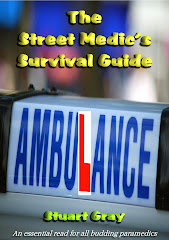
Night shift: Five calls; four by ambulance; one by car.
Stats: 1 NPC; 1 ?MI; 1 eTOH with VT; 1 faint; 1 assault with ? # nose.
My first call of the night was a no patient contact (NPC) because another FRU was already on scene for the 25 year-old female who fainted, so I left a few seconds after arriving.
Occasionally, we get what I call ‘bum-biting’ jobs; that is a call where everything looks routine and then the patient goes off on you suddenly, thus clinically biting you on the behind. My next call was to a 71 year-old man who had fainted; he was lying with his feet raised on the floor of an office, looking very pale indeed and sweating all over. Of course, this is significant but he was pain-free, had no cardiac history or any significant medical problems and he looked as if he was recovering. But alarm bells ring when a patient is slow to get their colour back and continues to sweat... and offers information you didn’t ask for yet, like ‘I have no heart problems’.
When the crew arrived I told them what I had and gave them my obs, which were normal and minimal because I’d only been there a minute or two. On the way down to the ambulance (in the lift), he stopped responding and lost consciousness and I had to keep his airway stable as we continued to wheel him to the vehicle. He had a pulse and was still breathing, so it was prudent to get him where we could do the best for him immediately, rather than stop, unload him and start wasting time. Then he had a ten-second tonic seizure, usually a sign of brain hypoxia and usually transient. He came to just as we were getting him into the ambulance.
His ECG was all over the place but there was no ST elevation, so we took him to the nearest hospital, rather than a specialist centre. His BP had dropped and he was bradycardic now. His pallor never improved and so I got my bag out, put a line in and prepared for the worst but he was talking lucidly to the crew and, although changes began to appear in the ECG, they weren’t yet decipherable as one thing or another, so I gave him no drugs and no fluids.
He was ‘blued’ in and the doctor couldn’t make head nor tail of it. I’d mentioned the possibility for a ‘silent MI’ for this patient – a pain-free heart attack – and it began to look likely. After three more ECG’s in Resus, the elevation in his chest leads began to increase and his T waves were inverted. I left the doctor to work out what to do next as she drew blood from his radial artery for confirmation. These changes are often very early signs of MI.
The next patient asked if there was a charge for him to be taken to hospital. He was drunk and vomiting in the street. His friend was with him and he too asked if a fee was involved for his mate’s care. I wonder if he’d have just gone home and sobered up, rather than accept our invitation to go to hospital if there was a charge.
Just as well he didn’t because after I’d let the crew (the same crew from the previous call) take over his care, one of them came to the car to tell me the patient had VT, a rapid heart rate. I went to see the ECG that was now being done and sure enough his heart was racing at almost 200 beats per minute. This lasted about five minutes before resolving itself and settling down to 90 bpm, with occasional dropped complexes. I have to admit reflecting on how easy it would have been to pack him into the ambulance like any other drunk and ignore alternative possibilities for his pale, vomiting presentation. The crew had been smart and quick-thinking to have realised his pulse wasn’t as it should have been because ECGs are not routinely carried out on inebriated young people, especially in the West End. I hadn’t even started obs on him myself because the crew were arriving with me and the man had busied himself by vomiting over my boots when I approached him but I still worry that this could have been missed if I had passed it over as ‘just another drunk’.
Clearly, he was drunk but equally something potentially dangerous could be going on with his heart. He didn’t take drugs and he was adamant on that point, so, unless it was just one of those anomalies that happen to young people, he may have an underlying cardiac problem that needs immediate assessment. We ‘blued’ this man in.
A 63 year-old Chinese man fell in the bathroom, knocking his head on the tiles and his anxious family called an ambulance because he was unconscious for a while and seemed to stop breathing. When I arrived, he was sitting in a chair in the little room, conscious and breathing but looking decidedly pale, so as soon as the crew arrived, he was taken to the ambulance and off to hospital. There was no bleeding and he had no significant medical history but his condition warranted further investigation.
Later on, an assault outside a club produced two patients, one of which was hyperventilating and was taken by ambulance – the other was left with me to convey in the car. This 22 year-old man had a possible broken nose as the result of being kicked in the face as he lay on the ground. It’s obviously very big and very brave of someone to kick a man when he’s down; let’s face it, he’s on the ground and no threat whatsoever, so what’s the point in risking a criminal record by continuing the assault?
Be safe.















3 comments:
Any ideas on your drunk patient? Had someone very similar a while back and I queried WPW which turned out to be the case! Didn't have the luxury of a normal ECG as he was in VT all the way to hospital!
InsomniacMedic
His ECG looked fine when it settled, except for those dropped complexes every so often. No block (P waves there), no Delta waves or wide QRS as would be expected in WPW, so still a mystery.
Good plan. Its Nice Horse Hospital.
Post a Comment